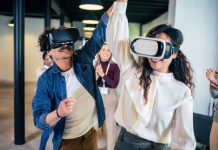
Anyone who has led workplace training has been there before. You are responsible for delivering an engaging lesson on which the company has spent thousands of dollars. Then, ten minutes into your PowerPoint presentation, you look out at an audience of zombies. They have blank stares, are on their phones, or are boldly catching a nap in broad daylight.
Your morale plunges, but you dutifully continue your presentation, subjecting the audience to death by PowerPoint, until finally, they are dismissed to go back to work. They leave without asking any questions and don’t even make eye contact with you on their way out the door.
Unfortunately, this scenario plays out far too often; however, there is a better way.
We Learn by Doing Things
Earlier this year, I was giving a presentation to a big group of industrial workers. I had mentioned using ‘point-of-use’ training where a QR code could be printed onto a sticker, stuck onto any item you needed to inspect, and then scanned by an employee when they needed to know how to inspect the item.
After the training was over, a foreman came up to me and said he didn’t understand the instructions on how to use a QR code. This is common, and although I included instructions in the presentation, a lot of people who aren’t tech-savvy struggle, so I usually help them after class.
I directed him to open his phone’s photo app, scan the code, and push the link that popped up. I did so by doing it for him the first time and thought he’d be able to manage it himself the next time.
“No, stop. Don’t show me how. Just tell me how and let me do it myself. Otherwise, I won’t learn.”
We went through the process again; this time, he slowly went through each step and did it on his own.
“That’s what you guys don’t understand. We learn by doing things.”
I knew that to be true from so many other training sessions I’ve taken, yet here I was, trying to get him to learn how I do it.
In hindsight, it’s important to remember that a lot of people learn by doing and as a result, occupational health and safety experts, like myself, need to adjust our lessons accordingly.
Know Your Audience
There’s a reason certain people don’t use the instructions when putting together a new piece of furniture. These same individuals also tend to find about as much value in an owner’s manual as they do use it for firewood. The reason is they don’t learn that way. They learn by doing it themselves and only ask for help after they run into an issue.
For those of us who learn differently, we likely spent years learning by watching and listening to our high school teachers and college professors. Because we spend so much time in school learning from this method, it’s what comes naturally to us when we teach. Unfortunately, this method skips the number one rule of training, and that is to know your audience.
As I have transitioned from a typical industrial safety career to one specializing in safety training videos, I have had to shift how I plan for training and, instead, plan for learning. My company, Ally Safety, focuses on safety videos that are entertaining, but hidden in that tagline, is the core mission of safety made understandable. It took thinking outside the box to change how I thought about training to make it engaging and valuable for my audiences.
After two years of making safety training videos, I now use the following principles to guide my work:
- A preference for self-directed learning
- A willingness to learn when transitioning into new roles
- A focus on immediately applying the knowledge to real-life situations and problems
- A tendency to be internally motivated
I’ve learned from creating training courses that you don’t need a first-rate camera crew, special effects, or a great beat to make training impactful – although these things certainly help. What you need is a why before the how, a good demonstration, and to let people try it on their own.
Tell it Like a Story
If you’ve taken any sort of a speaking course, you’ll know that people love stories and one of the easiest ways to engage an audience is through storytelling. The surprising thing is, you can do this with safety compliance training and quite easily. After all, there’s always a tragic tale about how we got to where we are now.
As an example, did you know that in the 1800s, match manufacturing involved dipping the tips of matches in white phosphorus, a substance that can cause jaw necrosis? In some cases, match factory workers’ jaws would rot out of their heads. What a nightmare! Of course, that was back before employers were required to inform employees about workplace hazardous substances – protection we now have through the Hazard Communication Program.
With a quick little story, you can bring attention to why knowing about hazardous substances at work is important for employees before getting into the how.
When it comes to how we need to be clear and concise. Drawing off the example above, you would probably want everyone to be able to look up a Safety Data Sheet (SDS) at work – a critical element of any Hazard Communication Program.
This doesn’t need to be flashy or flowery. Simply walk them through how to access it, and don’t forget to involve either pictures or video for every step of the way.
Next, go through an SDS together. Sometimes people need a little help to be introduced to these concepts. Reading them for themselves is a great way to start. Just do it in an environment where questions can be asked and answered as soon as possible.
Lastly, set up a situation where each person can do this themselves. It may involve some one-on-one time or a supervisor helping out, but it’s critical that everyone gets an opportunity to practice any new skill. After all, if they don’t immediately apply the knowledge, it tends to be lost.
Simple Training is Good Training
The best training has a few simple points that can be made without too much information. Keep it down to earth, easy to apply to real life, and ensure learners know the why behind the how.
At the end of the day, good training shouldn’t be complicated or boring. It should be engaging and delightfully simple.




